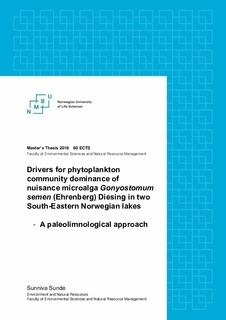| dc.description.abstract | Gonyostomum semen (Ehr.) Diesing has during the last decades expanded its distribution and increasingly started to dominate phytoplankton communities in Northern Europe, and particularly in Scandinavia. Several studies have recognized the species as invasive, and a recent immigration to Northern Europe within the last few decades has been hypothesized. Using paleolimnological methods, the current study aimed at using records of pigment compositions in sediment cores to investigate for phytoplankton community dominance of Gonyostomum , as well as for drivers of such development. It was hypothesized that dominance of Gonyostomum is a recent phenomenon within the last few decades and that it emerged simultaneously as changes in air temperature, precipitation and levels of allochthonous derived organic matter( DOC) in the lakes.
Sediment cores were obtained from two south‐eastern Norwegian lakes belonging to the same lowland watercourse and the same climatic zone( < 200 m.a.s.l). One of the lakes, Grepperødfjorden, proved to have a dominating population of Gonyostomum since the mid‐ 1930s, consequently contradicting prevailing assumptions of Gonyostomum as a recent invasive species to the ecoregion of South‐Eastern Norway. However, as dating of the sediment cores was determined exclusively by analyzing for Cs137 , there are uncertainties regarding sedimentation rates, particularly for lake Grepperødfjorden, and the finding of Gonyostomum as a dominating species in the mid‐1930s should therefore be considered preliminary.
The other lake, Bindingsvann, was found to have a dominating population of Gonyostomum from the mid‐1990s, corresponding with increasing air temperatures and levels of allochthonous derived organic matter in the lake. It was found that increasing air temperatures in combination with elevated levels of organic matter( DOC) most likely led to an intensification and prolonging of thermal stratification, favoring Gonyostomum which performs diurnal vertical migrations between the epilimnion and the hypolimnion. In a nutrient poor lake like Bindingsvann, this allows Gonyostomum to utilize nutrients in the deep strata during thermal stratification and internal loading and thereby outcompete other phytoplankton species and form large biomasses, leading to a noticeable increase in lake productivity. The signals of temperature as a driver for Gonyostomum dominance are less evident for lake Grepperødfjorden. This lake differs from the other in that it is shallower with less potential for thermal stratification. Several factors were found to potentially could explain the initial dominance of Gonyostomum in the estimated time of the mid‐1930s, such as human induced turbidity facilitating reduced light conditions, water leveling practices, high phosphorus levels and a lengthening of the growing season. As the dominance was inconsistent up until the estimated time of mid‐1970s, conditions promoting Gonyostomum growth appear to have improved as time has progressed. There are indications that this might be related to water color and visibility as well as to a lengthening of the growing season. | nb_NO |

